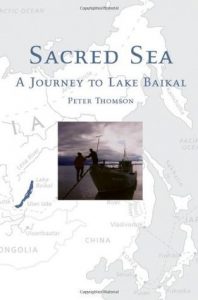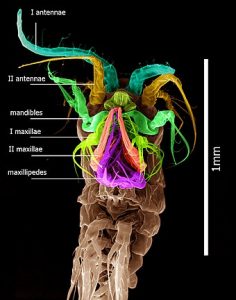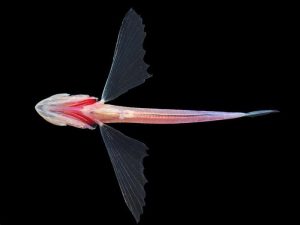 Sacred Sea: A Journey to Lake Baikal by Peter Thompson. Oxford UP: 2007.
Sacred Sea: A Journey to Lake Baikal by Peter Thompson. Oxford UP: 2007.
Review by David Sokurovi.
In the following research paper, I will be analyzing the book written by Peter Thomson — Sacred Sea: A Journey to Lake Baikal. The book was published by Oxford University Press in the year 2007 in New York, NY. To go into more detail, Sacred Sea is this highly analytical and one-of-a-kind travel literature documented by Peter Thomson, which portrays the fascinating and, at times, astonishing facts about Lake Baikal in Siberia to the general public.
Peter Thomson himself is a journalist who has spent quite a fair share of his career in environmental journalism. To be more specific, Thomson is a Founding Producer and Senior Editor of NPR’s “Living on Earth” and recipient of 19 awards for excellence in broadcast journalism (Thomson 2021). Nevertheless, today, he is a freelance environmental journalist and a member of the Executive Committee of Society of Environmental Journalists (Thomson 2021).
Regarding the content of the book, as already mentioned, Sacred sea is a travel log, which follows along and documents the journey of Peter Thomson and his younger half-brother from the US to Siberia. During this journey, the two brothers unravel the extraordinary beauty and extravagance of the world’s oldest and deepest lake. Moreover, they examine the immense historical, and geological value Baikal possesses and evaluate the natural power of the lake, which, as we learn from the book, is evident in its direct linkage to the ecological well-being of the surrounding ecosystems. On top of that, Sacred Sea also brings to light the numerous environmental hazards currently enacted in the midst of the Lake that sadly are not brought to the general population’s attention. Moreover, throughout the book, Thomson establishes from his observations that the lake’s current state has been inflicted by many selfish people who have no intent in maintaining the ecological integrity of this priceless lake.
Additionally, it is worth mentioning that Peter Thomson structures the book in an exciting manner. Specifically, the book is broken down into three main parts, each of which mainly talks about one respective domain. To specify, Part I primarily discusses all of the massive geological aspects of Baikal, which make the lake genuinely unique; we start learning about the remarkable zooplankton Ebischura Baicalensis, the highly interesting Golymyanka, and the one and only Nerpa, to name a few. Moreover, Part I also discusses the historical value of the lake and outlines how ancient it is: “It’s at least 25 million years old—the oldest body of fresh water on the planet, more than a thousand times older than North America’s Great Lakes. Before there was Russia or Russians, before there were people or even apes, there was Baikal” (Thomson 2007). On the other hand, Part II primarily talks about Peter Thomson’s journey to the lake. It also touches upon his discoveries of the surrounding villages and settlements. And lastly, Part III is a general recap of all of the information we were introduce to in Parts I and II.

It is undoubtedly clear that throughout the book, we encounter numerous interesting chapters, which portray many fascinating facts and discoveries, such as the ones mentioned above regarding the endemic species and the overall age of the lake. However, it is worth outlining that the chapter which grabbed my attention the most was: Chapter 5: Into the Lake — Deep. I mainly found the following chapter overtly fascinating because, as the title implies, it describes the lake from within its depth and, thus, begins introducing us to all of the species that exclusively reside in Baikal. To be more specific, the chapter starts with introducing us to a zooplankton called Ebischura Baicalensis; we particularly learn about the interesting capability this creature possesses, which is its ability to filter a cup of water a day, that, in terms, creates Baikal’s unique natural filtration system. Moreover, Thomson also mentions how much the existence of this particular creature is tied to Baikal: “It’s said that they can’t live even in a glass of Baikal water removed from the lake” (Thomson 2007). Thomson describes this phenomenon by jokingly saying that “perhaps they die of homesickness” (Thomson 2007).

The following chapter also discusses another endemic species of Lake Baikal, which is the Golomyanka. The book specifically mentioned that this particular fish has several unique attributes: the ability to spawn up to 3000 fully formed offsprings and the abundant existence of highly nutritious fat in it. It also mentioned that “there are almost as many Golomyankas in the lake as there are people on earth” (Thomson 2007). Therefore, it could be said that Lake Baikal has quite a number of this particular species.
Furthermore, this chapter also mentions that unlike any other lake on the planet, Baikal has oxygen in even its very depths. However, Chapter 5 does mention that scientists still cannot establish why the following is possible. Moreover, Thomson even says that “it’s possible that you and I will be dead before they figure it out.” The science of deep-water lakes in general still isn’t very well understood, and as we know” (Thomson 2007).

Lastly, Chapter 5 talks about the one and only freshwater seal on the planet — Nerpas. Thomson mentions that these extraordinary creatures have quite the resilience that allows them to swim up to 300 meters deep into the lake. Moreover, they are quite fast swimmers and, in fact, long-livers. Peter Thomson even mentions that, like many other aspects of the lake, the origin of Nerpas in Baikal is a mystery to this day. However, the book proposes one possible explanation to the following: it is entirely plausible that the ancestors of Nerpas swam 3000 kilometers by rivers from the nearest sea and, due to the right geological factors, settles in Baikal. Although this might be one possible explanation, scientists still do not have a clear answer to this day.
Although the book is written in a highly compelling and elegant manner, I still had a handful of critiques I would like to address. To begin with, the whole idea of the book seemed off-putting from the very beginning. To specify, it is clear that Peter Thomson had achieved quite the success in his career; nevertheless, he chose to give everything up and travel to a distant land with his brother. With this being said, at times the book felt like Peter Thomson’s reflection on his personal life rather than an academic review of the lake. On top of that, I would also like to mention that I felt that I was not given enough explanation of the content described in only a few chapters. For example, in the chapter when the author talks about the origins of Nerpas, Thomson only briefly mention that with the settlement of humans in the midst of the lake, the link which connected the sea and Baikal got blocked off; however, we never get a clear picture to what precisely the author is referring to.
Overall speaking, the following book represents a valuable and fascinating academic work which, based on the numerous published reviews from editors as bing as The Phoenix, BBC Focus Magazine, and New York Times, is indeed a one of a kind. Moreover, it is worth mentioning that Peter Thomson is a fantastic reporter who makes sophisticated political and scientific issues easy to understand. Therefore, Sacred Sea has genuinely equipped me with a solid understanding of Baikal’s ecosystem; it introduced me to various unique species of the lake in a simple and elegant manner that genuinely made me feel like I was exploring them myself.
Work Cited
Peter Thomson, LinkedIn, 2021. Https://Www.linkedin.com/in/Peterthomson/
Thomson, Peter. Sacred Sea: A Journey to Lake Baikal. Oxford University Press (New York, NY), 2007.